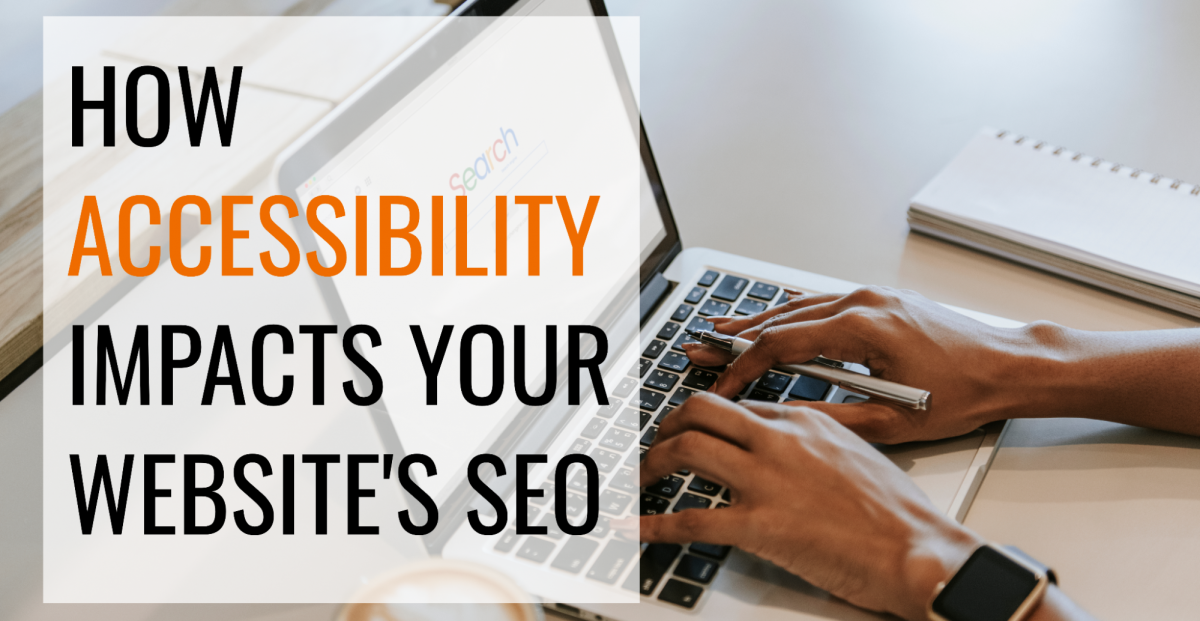We all know the importance of keywords when it comes to driving your SEO, but not enough people recognize another avenue of website development that deserves just as much time and research. One of the often overlooked ways to boost your reach and audience is to adjust your web accessibility. Creating an accessible website means that you’ll be able to reach a larger audience and also improve its overall performance.
But what do we mean by the term website accessibility?
By definition, website accessibility is a term that means a website is usable by all people. The term focuses on how people with disabilities can enjoy access and benefit from a site, application, or system without navigation issues or interaction challenges. Pictures are described for the visually impaired, menus are easy to access and navigate, and the general structure of your site is simple so that it can be navigated easily.
The Benefits of Web Accessibility for SEO
According to the World Bank, the number of people with disabilities is 15% of the global population. If we take a look closer to home in the U.S., nearly 20% of people are diagnosed with having a disability.
Website accessibility is therefore essential as it ensures that all people can enjoy access to digital information and use digital content. Designing a website with web accessibility in mind means that you create a user experience that ensures diverse audience members feel welcomed by your brand.
However, despite the fact that many people have a disability, the Bureau of Internet Accessibility has stated that many marketers have mostly treated website accessibility as an afterthought to their content development, as opposed to using it as a crucial pillar.
A study conducted by Search Engine Journal in 2020 discovered that 58% of the SEO community always considers accessibility when working on a site’s SEO. However, the same study showed that 17.9% of respondents said that they don’t consider website accessibility or that they didn’t even know that they should be.
This is a problem for several reasons. Firstly, if SEO developers do not consider web content accessibility guidelines, economically speaking, they are ignoring a community of people who not only deserve careful consideration, but are valid customers and clients. According to Stardust Testing, reaching this community could equate to more than $350 billion of extra spending in the United States alone.
However, it is not just economically more viable to focus on website accessibility. It can also improve your SEO as well.
Alongside enhancing SEO, the W3C (World Wide Web Consortium) also cites that accessibility links well with other best practices, including device independence, mobile web design, usability, design for older users, and multi-modal interaction. W3C shares that case studies have proven that accessible websites are advantageous as they have reduced maintenance costs, better search results, and increased audience reach.
Web Accessibility Focuses on User Experience
What website accessibility and SEO strategies have in common is that in order to deliver a good user experience (UX), the design places the user first. Great questions that web designers and SEO developers can ask themselves when it comes to web accessibility and SEO are, ‘How can I navigate this website without having to really think about it?’ or, ‘How can a website be more intuitive and easy to follow?’
For instance, for people who may have limited reading comprehension, using good header structure that establishes a clear content hierarchy is helpful. It enables people to identify which sections are worth reading and perhaps which ones they can skip over.
If we take a look at the same user experience but from an SEO perspective, establishing a good header structure helps to implement the use of heading tags in order to help a page or piece of content rank higher on a search engine. This is a great strategy for people who use screen readers or who may have visual impairments.
Get our GN - How Web Accessibility Impacts Your Website’s SEO delivered right to your inbox.
How to Implement Accessibility Into Your Website for an SEO Boost
Accessibility equates to better quality websites that are inclusive and have a greater audience reach. For entrepreneurs in the ecommerce sector, there is great value to be gained by making accessibility a priority. However, how do you put this into practice?
Here’s a list of tips for you to use to enhance your web accessibility:
Create Alt Text
Creating alternative (alt) text for graphics and images for your website will make it easier for users who have visual impairments to use your site. It also helps search engines to understand the visual content they are seeing.
When creating alt text content for your ecommerce business, you should ask yourself this question “Would a user still understand the context if I were to remove all the images from the website and just leave the alt text in its place?”
The benefit of providing alt text for images is that it opens your website up to being a source of organic traffic via Google in the form of additional scannable keywords, and Google Images. Some people who use the internet will purely go to a webpage after choosing an image that is hyperlinked in the image SERP (search engine results page).
Use Video Transcripts
If a user has a hearing impairment or your user is a person in a public space but they don’t have access to earphones, video transcripts are an excellent way for them to understand the content they are viewing. This improves SEO as search engines can then also pick up on the content.
Subtitles have actually become very popular among television and movie viewers as they improve comprehension, so even those outside of the disabilities spectrum are seeing the benefits of this addition.
Consider Readability
It is no secret that content that is easy to understand is welcomed by all. Readability benefits all users. Google likes content that is concise, clear, and easy to understand. You can achieve this by doing the following:
- Reducing your sentence length. Think about using full stops instead of commas to break up ideas.
- Break up large pieces of content by using headings and bullet points.
- Adjust your language to suit your audience. Where and if possible, use simple and shorter words. The best-consumed content sits at a grade three reading level.
If you would like to determine the readability of your website, you can easily establish the readability of your content by using websites such as Readable or Sitechecker.
Organize Site Structure
When it comes to creating a web accessibility strategy, site structure is key. It is important that users can navigate through content at ease and can quickly find the relevant information they need. It’s important for ecommerce sites to have clear navigation and organization of categories, use breadcrumb navigation, and provide a sitemap.
Use Title Tags
After content, title tags are the second most important on-page factor when it comes to SEO. On SERP, page titles are displayed at the ‘Headline’. Having useful title tags means that all users can have access to the content, and those title tags get picked up by Google search engines.
Use Schema Markup to Generate Rich Media Content
Schema.org is a programming vocabulary that was developed by Microsoft, Yahoo, Google, and Yandex. Through the group’s developed schema markup (otherwise known as structured data), it provides search engines with the language to understand your content. It is pretty much a universally recognized way for helping search engines to understand your website, which should have an impact on your SEO as well.
However, Schema.org also carries accessibility properties through its AccessForAll specification. This sets out accessibility metadata terms so that people can easily find content that meets their own individual requirements and needs. Using the Schema Markup, therefore, not only improves your SEO, it also improves your accessibility.
Use Descriptive Links
An important part of your client’s journey on your website is carried out via the use of interlinking. This is the process whereby a user clicks on a link to arrive at another webpage. In order to guide and aid the user experience, the text used should be descriptive. In terms of accessibility, using descriptive links empowers a person to understand a link’s purpose before they click it.
For instance, the words ‘read here’ or ‘click here’ fail to give the user information regarding context. For someone who is a screen reader, they can navigate all links of a page before finding out where they really want to go. Descriptive text, however, helps people easily explore a web page as they have some pre-information as to what the link will educate them about.
Descriptive text also meets the web accessibility requirements of WCAG. This includes: Success Criterion 2.4.4: Link Purpose (In Context) and Success Criterion 2.4.9: Link Purpose (Link Only).
Descriptive text also supports SEO. Use anchor text that makes sense. Hyperlink the words that will tell the search engines what a site is about is important.
Clever Consideration of Breadcrumbs
For both accessibility and SEO, using breadcrumbs for content has its benefits. Breadcrumbs describes a series of links that help users determine where they are when navigating a website. Breadcrumbs are a secondary way of exploring a website and they are used to trace and monitor movements through a set of group pages. They enhance the user experience as they help users go back from one page to another and users can easily return to a main page.
Breadcrumbs meet web accessibility requirements of WCAG 2.1. By implementing them in your content, you will meet the Success Criterion 2.4.8: Location. Breadcrumbs boost accessibility as they are particularly helpful for people with disabilities related to low attention spans or memory loss.
By being able to backtrack through links, breadcrumbs ensure that people don’t get lost or confused as they flow through a set of pages that are grouped together. This, in turn, helps SEO as search engines use breadcrumbs to understand how a site is organized.
FAQs on Web Accessibility for SEO
Do accessible websites rank higher?
Making your website more accessible also increases its readability and usage of keywords. These are things that Google definitely picks up on and likes, so there’s a good chance that it will improve your Google ranking.
What is ADA compliance?
ADA compliance is the Americans with Disabilities Act for Standards for Accessible Design. It includes a set of rules and regulations that prevents electronic discrimination against people with disabilities.
How does my website become ADA compliant?
The Business News Daily states, “There are no clear ADA regulations that spell out exactly what compliant web content is, but businesses that fall under ADA Title I or ADA Title III are required to develop a website that offers “reasonable accessibility” to people with disabilities.”
Next Steps: How to Test Your Website’s Accessibility
Now you have explored ways to boost your web accessibility while also improving your SEO, but it’s important that you do not overlook the importance of continuous accessibility tests. Accessibility tests enable you to rectify any design flaws that could potentially hinder the performance of your website.
Step One: There are several tools that you can check to see whether your website is accessible or not. One tool that is particularly useful is Google Lighthouse. It carries out an accessibility audit of your website and then provides you with a detailed analysis.
The analysis includes a list of all issues that prevent a website being fully accessible and provides scores on each point. Each audit gives suggestions as to how to increase the scores so your website can become more accessible.
Some other websites that perform insightful accessibility checks that we recommend are:
Step Two: Do an accessibility audit of your website quite frequently. An accessible website is a better website overall – for the consumer and for your business’s benefit. When web designers and developers seek to make improvements that enhance the user experience of people with disabilities, the end result is creating something that benefits their entire audience.
Step Three: Top things up. Whether it is through the use of alt text, readability, site structure, video transcripts, or title tags, each piece needs to be altered with thought and consideration for the user, not just your SEO. When consciously and authentically, not only does web accessibility improve the performance of your website, it also makes your business more inclusive and broadens your economic horizons.
If you would like to scale your business, reach out today to schedule a free 20-minute consultation. Let’s find some strategies that you can start implementing right away that will help you to grow.
Get our GN - How Web Accessibility Impacts Your Website’s SEO delivered right to your inbox.







